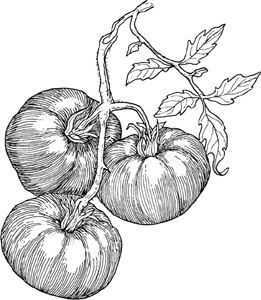
BOTANICAL NAME: Lycopersicon lycopersicum
FAMILY: Solanaceae

Tomatoes have never been as popular in Germany as they are in the United States. Even though some of the first tomatoes depicted in botanical books were grown in German plant collections during the Renaissance, the cool climate has always worked against tomato growing and limited the choices of German kitchen gardeners. It was not until after the unification of Germany in the 1870s that German plant breeders turned their attention to tomatoes and began developing varieties better adapted to their climate. Compared with the output of such American tomato breeders as Alexander Livingston (1822–1898), that list of German varieties is noticeably short. However, one very special variety stands out above the rest.
Its original German name is Königin der Frühen (Queen of the Earlies). In France, it became Reine des Hàtives and it debuted on the scene in 1898. The Viennese seed company of Wolfner & Weisz announced the appearance of this new tomato with considerable fanfare and a gorgeously drawn illustration showing the fruit with its distinctive shape. Here we must pause to translate into Viennese, since they call tomatoes Paradiesäpfel (apples of Paradise), an old-fashioned word for tomato that also appears in Hungarian as paradicsom alaku (tomato shaped) when describing flat tomato-shaped peppers. The linguistic complexities of the old Austro-Hungarian Empire become obvious and add their own layer of murkiness over the origins of many old heirlooms from that part of Europe.
Exactly how Queen of the Earlies came about remains somewhat hazy. There was a red American tomato called Queen that appeared in 1885, but much earlier than that (in 1875) the seed firm of David Landreth and Sons of Philadelphia listed a red German tomato called König der Frühen (King of the Earlies), and doubtless he was meant to be the consort for this newer and rather attractive introduction.
The thing that I like about Königin der Frühen is the size and shape. The three-inch diameter fruit hangs in clusters of two or three, sometimes even four fruits. It is dull orange red in color, very smooth, almost waxy in feeling, well shaped, and somewhat flat. It is a nice size for salads and sandwiches, and because it is not large like the beefsteak types now so popular it is not given to cracking and some of the other maladies affecting oversized tomatoes. It also has an interesting sweet flavor, a rather smooth, silky texture, and sports a whitish-yellow variant form called Goldene Königin, which is the same shape.
In terms of early-ripening heirloom tomatoes, Königin der Frühen is indeed early, for it matures the same time as Chalk’s Early Jewel and June Pink—both American heirlooms from roughly the same period. Among the German heirlooms, its earliness is comparable to Haubners Vollendung (Haubner’s end-all), a small heart-shaped variety excellent for cooking, and Rheinlands Ruhm (fame of the Rhineland), a small, round red variety with a sweet-tasting yellow seed mass. All three of these red German tomatoes were developed for cool climate conditions and may be grown with relative success even in rainy areas like Portland, Oregon.